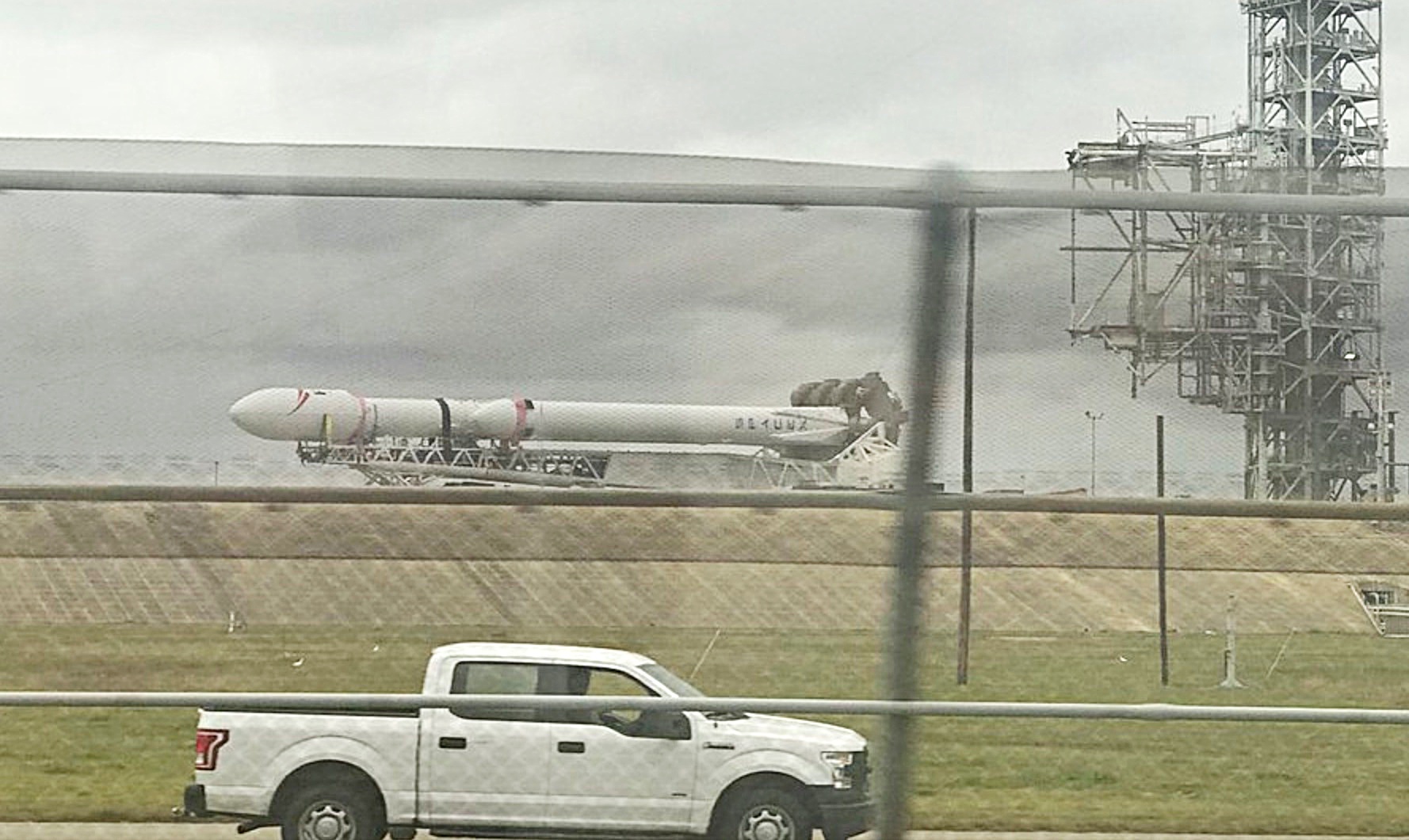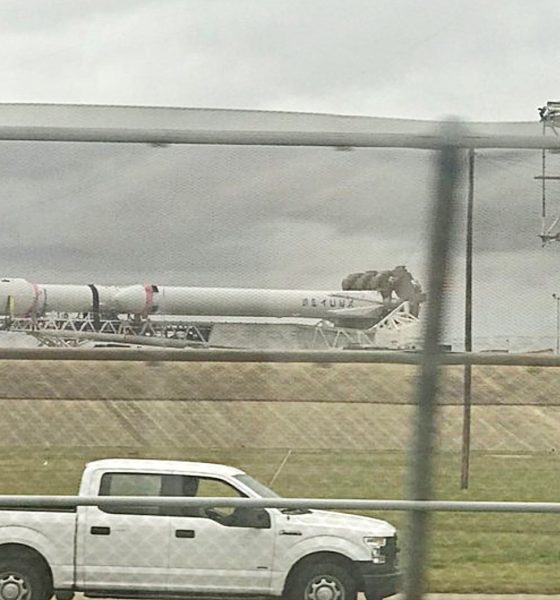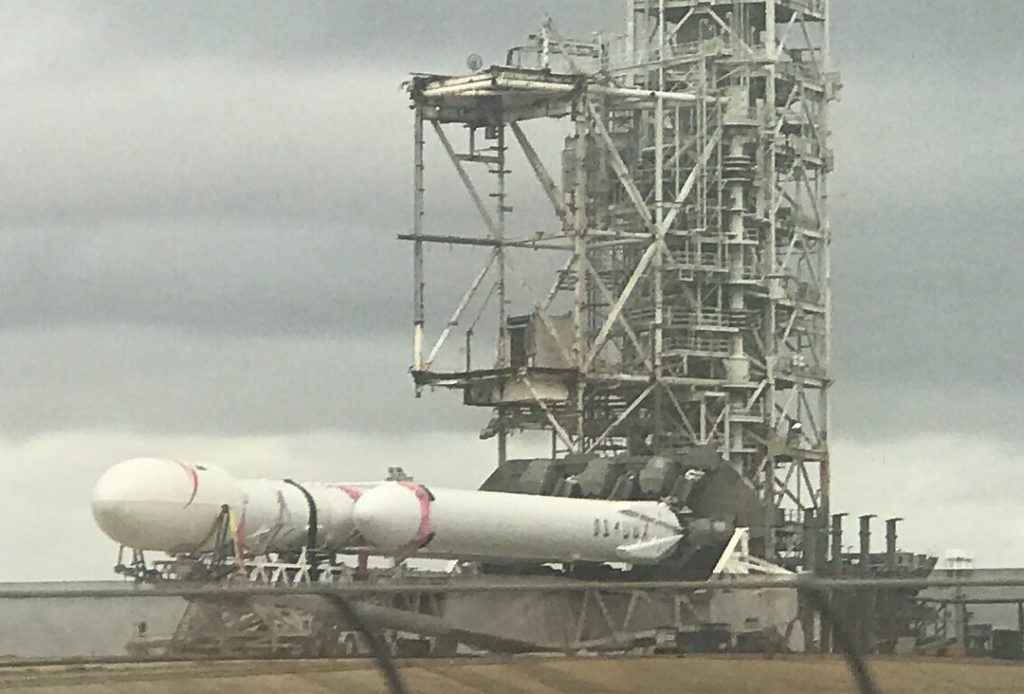

News
SpaceX Falcon Heavy spied on the move ahead of test fire
While touring Florida’s Kennedy Space Center by bus earlier this morning (January 8), several spaceflight fans captured SpaceX’s Falcon Heavy rolling out to Pad 39A for the second time ever. Following a basic fit check and photo opportunity at the launch pad in the last week of 2017, the launch vehicle now appears to be prepped and ready for its first wet dress rehearsal (WDR) and static fire test.
If all goes well during the wet dress rehearsal’s propellant loading tests, an admittedly less than guaranteed outcome, then the WDR will likely translate into a momentous occasion for the massive rocket: the first-ever simultaneous ignition of all three of its integrated first stages and their 27 Merlin 1D engines. While relatively unique to SpaceX, the company has made a habit of testing each and every new Falcon 9 first stage with two full-up static fire ignitions, one at McGregor, Texas and the other at the vehicle’s given launch pad. Following the destructive failure of Falcon 9 during a September 2016 static fire test, SpaceX further upped their cautious procedures by removing the payload for all future static fires, lest the customer request that it remain integrated for the sake of time savings.
Unsurprisingly, no customers have since chosen to bypass SpaceX’s new risk-reducing procedures. Falcon Heavy will clearly be a return to older methods, delineated by the clear presence of the second stage and Tesla Roadster payload at its top, although this decision was almost undoubtedly driven by the fact that the payload is in no real way valuable or even important for the “customer,” SpaceX itself. The Tesla Roadster is more or less a stand-in for the traditional boilerplate satellite (read: hunk of dead metal) often launched during the inaugural flights of new rockets. The best recent example is the 2004 inaugural launch of Boeing’s Delta IV Heavy rocket, similar to Falcon Heavy in the sense that it also features a triple-core first stage. Its first launch carried a payload that was quite literally a 6000 kg (13500 lb) piece of metal paired with a number of sensors used to gather vibrational data.
- A GIF of Delta IV Heavy’s inaugural 2004 launch. The mission was a partial failure. (ULA)
- The mission’s DemoSat, a 6100kg hunk of metal (and two DoD nanosats). (ULA)
Somewhat fittingly, Delta IV Heavy is aiming to conduct its own launch within the next week or so, providing the East Coast with back to back launches of the world’s two largest operational rockets. Still, as SpaceX and Elon Musk have repeatedly mentioned, Falcon Heavy is far more capable than even Delta IV Heavy: while Falcon Heavy is noticeably shorter, narrower, and thinner than Delta, it weighs almost twice as much and will sport nearly 2.5 times the thrust at liftoff.
Delta IV Heavy’s launches are undoubtedly spectacles to behold, particularly given explosive launch procedures, but the vehicle is entirely expendable, whereas Falcon Heavy will attempt recovery of all three of its first stages, and may eventually allow SpaceX to test technology that will enable second stage recovery, as well.
Falcon Heavy will launch a somewhat livelier version of Delta IV Heavy’s boilerplate mass-simulator with the Tesla Roadster, and the main goal is quite clearly to test the vehicle’s ability to send a payload into a trans-Martian injection (TMI) orbit, albeit likely without an actual injection into orbit around Mars at the other end. Even if the payload is somewhat silly, a successful launch to TMI would be the most literal step yet made by the commercial space company along its path to Mars. If this week’s propellant loading and static fire go as planned, launch will likely follow within a week or so – maybe two weeks given the new and unpredictable nature of testing what is more or less a prototype rocket.
Falcon Heavy goes vertical pic.twitter.com/uG1k0WISv1
— Elon Musk (@elonmusk) January 5, 2018
Falcon Heavy can be expected to go vertical at the pad within the next 12-24 hours at most, and static fire will follow soon after. After a highly successful evening photographing the January 7 launch of Falcon 9 with Zuma, Teslarati’s launch photographer Tom Cross will be attempting to photograph the momentous test fire as it happens, and you can follow along live on Teslarati’s Instagram.

News
Tesla (TSLA) receives “Buy” rating and $551 PT from Canaccord Genuity
He also maintained a “Buy” rating for TSLA stock over the company’s improving long-term outlook, which is driven by autonomy and robotics.

Canaccord Genuity analyst George Gianarikas raised his Tesla (NASDAQ:TSLA) price target from $482 to $551. He also maintained a “Buy” rating for TSLA stock over the company’s improving long-term outlook, which is driven by autonomy and robotics.
The analyst’s updated note
Gianarikas lowered his 4Q25 delivery estimates but pointed to several positive factors in the Tesla story. He noted that EV adoption in emerging markets is gaining pace, and progress in FSD and the Robotaxi rollout in 2026 represent major upside drivers. Further progress in the Optimus program next year could also add more momentum for the electric vehicle maker.
“Overall, yes, 4Q25 delivery expectations are being revised lower. However, the reset in the US EV market is laying the groundwork for a more durable and attractive long-term demand environment.
“At the same time, EV penetration in emerging markets is accelerating, reinforcing Tesla’s potential multi‑year growth runway beyond the US. Global progress in FSD and the anticipated rollout of a larger robotaxi fleet in 2026 are increasingly important components of the Tesla equity story and could provide sentiment tailwinds,” the analyst wrote.
Tesla’s busy 2026
The upcoming year would be a busy one for Tesla, considering the company’s plans and targets. The autonomous two-seat Cybercab has been confirmed to start production sometime in Q2 2026, as per Elon Musk during the 2025 Annual Shareholder Meeting.
Apart from this, Tesla is also expected to unveil the next-generation Roadster on April 1, 2026. Tesla is also expected to start high-volume production of the Tesla Semi in Nevada next year.
Apart from vehicle launches, Tesla has expressed its intentions to significantly ramp the rollout of FSD to several regions worldwide, such as Europe. Plans are also underway to launch more Robotaxi networks in several more key areas across the United States.
News
Waymo sues Santa Monica over order to halt overnight charging sessions
In its complaint, Waymo argued that its self-driving cars’ operations do not constitute a public nuisance, and compliance with the city’s order would cause the company irreparable harm.

Waymo has filed a lawsuit against the City of Santa Monica in Los Angeles County Superior Court, seeking to block an order that requires the company to cease overnight charging at two facilities.
In its complaint, Waymo argued that its self-driving cars’ operations do not constitute a public nuisance, and compliance with the city’s order would cause the company irreparable harm.
Nuisance claims
As noted in a report from the Los Angeles Times, Waymo’s two charging sites at Euclid Street and Broadway have operated for about a year, supporting the company’s growing fleet with round-the-clock activity. Unfortunately, this has also resulted in residents in the area reportedly being unable to sleep due to incessant beeping from self-driving taxis that are moving in and out of the charging stations around the clock.
Frustrated residents have protested against the Waymos by blocking the vehicles’ paths, placing cones, and “stacking” cars to create backups. This has also resulted in multiple calls to the police.
Last month, the city issued an order to Waymo and its charging partner, Voltera, to cease overnight operations at the charging locations, stating that the self-driving vehicles’ activities at night were a public nuisance. A December 15 meeting yielded no agreement on mitigations like software rerouting. Waymo proposed changes, but the city reportedly insisted that nothing would satisfy the irate residents.
“We are disappointed that the City has chosen an adversarial path over a collaborative one. The City’s position has been to insist that no actions taken or proposed by Waymo would satisfy the complaining neighbors and therefore must be deemed insufficient,” a Waymo spokesperson stated.
Waymo pushes back
In its legal complaint, Waymo stated that its “activities at the Broadway Facilities do not constitute a public nuisance.” The company also noted that it “faces imminent and irreparable harm to its operations, employees, and customers” from the city’s order. The suit also stated that the city was fully aware that the Voltera charging sites would be operating around the clock to support Waymo’s self-driving taxis.
The company highlighted over one million trips in Santa Monica since launch, with more than 50,000 rides starting or ending there in November alone. Waymo also criticized the city for adopting a contentious strategy against businesses.
“The City of Santa Monica’s recent actions are inconsistent with its stated goal of attracting investment. At a time when the City faces a serious fiscal crisis, officials are choosing to obstruct properly permitted investment rather than fostering a ‘ready for business’ environment,” Waymo stated.
News
Tesla FSD v14.2.2 is getting rave reviews from drivers
So far, early testers have reported buttery-smooth drives with confident performance, even at night or on twisty roads.

Tesla Full Self-Driving (Supervised) v14.2.2 is receiving positive reviews from owners, with several drivers praising the build’s lack of hesitation during lane changes and its smoother decision-making, among others.
The update, which started rolling out on Monday, also adds features like dynamic arrival pin adjustment. So far, early testers have reported buttery-smooth drives with confident performance, even at night or on twisty roads.
Owners highlight major improvements
Longtime Tesla owner and FSD user @BLKMDL3 shared a detailed 10-hour impression of FSD v14.2.2, noting that the system exhibited “zero lane change hesitation” and “extremely refined” lane choices. He praised Mad Max mode’s performance, stellar parking in locations including ticket dispensers, and impressive canyon runs even in dark conditions.
Fellow FSD user Dan Burkland reported an hour of FSD v14.2.2’s nighttime driving with “zero hesitations” and “buttery smooth” confidence reminiscent of Robotaxi rides in areas such as Austin, Texas. Veteran FSD user Whole Mars Catalog also demonstrated voice navigation via Grok, while Tesla owner Devin Olsen completed a nearly two-hour drive with FSD v14.2.2 in heavy traffic and rain with strong performance.
Closer to unsupervised
FSD has been receiving rave reviews, even from Tesla’s competitors. Xpeng CEO He Xiaopeng, for one, offered fresh praise for FSD v14.2 after visiting Silicon Valley. Following extended test drives of Tesla vehicles running the latest FSD software, He stated that the system has made major strides, reinforcing his view that Tesla’s approach to autonomy is indeed the proper path towards autonomy.
According to He, Tesla’s FSD has evolved from a smooth Level 2 advanced driver assistance system into what he described as a “near-Level 4” experience in terms of capabilities. While acknowledging that areas of improvement are still present, the Xpeng CEO stated that FSD’s current iteration significantly surpasses last year’s capabilities. He also reiterated his belief that Tesla’s strategy of using the same autonomous software and hardware architecture across private vehicles and robotaxis is the right long-term approach, as it would allow users to bypass intermediate autonomy stages and move closer to Level 4 functionality.











